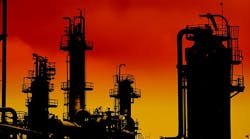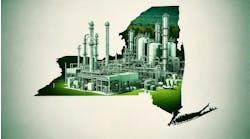According to Lawrence Livermore National Laboratory, roughly 51% of the energy supplied to industrial consumers ends up as rejected energy. This headline number creates the impression industry is an inefficient user of energy and, so, scope exists for major improvements within the sector, especially in the area of waste heat recovery. However, the truth is a bit more nuanced.
Many operations in industry depend on heat cascading from high temperatures to low temperatures. Within the process sector, this is seen most clearly in distillation, the dominant method for separating liquid streams. High-temperature heat is supplied to the reboiler. This evaporates volatile liquids, which then condense at a much lower temperature — often so low the heat is no longer useful, and must be rejected to the ambient environment as a waste.
Various ways to improve the efficiency of distillation columns exist. These include modifications to column internals (e.g., use of various packing materials), which can improve contacting and separation of fluids, and reduce the pressure drop through the column. Other options are based on waste heat recovery; for example, using the hot bottoms stream from a distillation column to preheat the cold feed (feed/bottoms heat exchange), or using the overhead vapor from a high-pressure distillation column, which operates at a high temperature, to reboil a column that operates at a lower pressure and temperature (double-effect distillation).
Interestingly, although these methods do reduce energy consumption, they do not necessarily reduce the percentage of heat that is rejected. Consider double-effect distillation. Let’s suppose the two columns require the same amount of reboiler heat, 10 mmBtu/h, and all of the heat passes through the columns, exits in the overhead vapor stream, and is rejected to ambient through overhead condensers. In this case, the heat supplied to the reboilers is 2×10 = 20 mmBtu/h, and the rejected heat is also 2×10 = 20 mmBtu/h. The percentage of the rejected heat is therefore 20/20×100 = 100%.
If we couple the two columns in a double-effect configuration, the high-pressure overhead discharges its heat to the low-pressure reboiler. We only supply external heat (10 mmBtu/h) to the high-pressure reboiler, and we only reject heat (10 mmBtu/h) from the low-pressure overhead vapor. The percentage of the heat that is rejected is therefore 10/10×100 = 100%. What went wrong? Nothing. We simply used all of the heat twice before rejecting it. We, therefore halved our energy consumption, while still rejecting all of the heat — but we used it twice before rejecting it.
Let’s now consider the energy impact on a complete chemical plant or refinery unit. Let’s assume the plant’s energy input is 100 mmBtu/h, and its rejected energy is 50 mmBtu/h, or 50%. The plant contains the two separate distillation columns we just discussed. Each column consumes and rejects 10 mmBtu/h of heat, and these heat flows are included in the plant’s total energy input of 100 mmBtu/h and total rejected energy of 50 mmBtu/h.
If we reconfigure the columns as a double-effect system, we know from our earlier discussion that this reduces both the heat input and the rejected energy by 10 mmBtu/h. The overall percentage of the energy rejected by the plant is now (50-10)/(100-10)×100, or 44.4%. In other words, even though the double-effect arrangement does not change the percentage of the energy rejected by the distillation system, it does reduce the percentage of energy rejected by the overall plant.
This is a highly idealized example. However, the overall concept is sound.
Other options exist that sometimes can achieve greater energy savings. These range from incremental improvements in equipment such as electric motors, to alternative separation technologies such as membrane systems, to radical redesign of processes, including new chemical pathways and new feedstocks. However, as long as a large percentage of the operations in our processes depend on cascading heat, the percentage of energy that ends up rejected will inevitably remain high.



